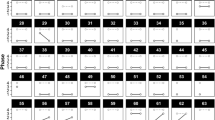Abstract
The preventative psychosocial effects of an intensive summer residential program for children with communication disorders related to cleft lip and palate are evaluated. Twelve children completed the five-week program. Following the program, the children increased their social interaction rates during observed interactions with nonhandicapped peers and according to parent ratings. Less difference existed between the children's perceived reinforcement value of peer interactions, and their expectancies for initiating such interactions. The limitations of these findings due to the small sample size and the lack of a control group are discussed. The value of multimethod measurement systems are also discussed.
Similar content being viewed by others
References
Richman LC, Harper DC: Self-identified personality patterns of children with facial or orthopedic disfigurement.Cleft Palate J 16: 257–161, 1979.
Simonds JF, Heimburger RE: Psychiatric evaluation of youth with cleft lip-palate matched with a control group.Cleft Palate J 15: 193–201, 1978.
Richman LC: Behavior and achievement of cleft palate children.Cleft Palate J 13: 4–10, 1976.
Starr P, Chinsky R, Canter H, Meier J: Mental motor, and social behavior of infants with cleft lip and/or cleft palate.Cleft Palate J 14: 140–147, 1977.
Van Demark DR, Vam Demark AA: Speech and sociovocational aspects of individuals with cleft palate.Cleft Palate J 7: 284–299, 1970.
Gluck MR, McWilliams BJ, Wylie HL, Conkwright EA: Comparison of clinical characteristics of children with cleft palates and children in a child guidance clinic.Percept Mot Skills 21: 806, 1965.
Brantley HT, Clifford E: Maternal and child locus of control and field-dependence in cleft palate children.Cleft Palate J 16: 183–187, 1979.
Kapp K: Self-concept of the cleft lip and or palate child.Cleft Palate J 16: 171–176, 1979.
Brantley HT, Clifford E: Cognitive, self-concept and body image measures of normal, cleft palate, and obese adolescents.Cleft Palate J 16: 177–182, 1979.
Cowen EL: Emergent approaches to mental health problems: An overview and directions for future work. In E Cowen, E Gardner, & M Zax (Eds),Emergent Approaches to Mental Health Problems. New York, Appleton-Century-Crofts, 1967.
Campbell D, Stanley JC:Experimental and Quasi-Experimental Designs for Research. Chicago, Rand McNally, 1963.
Dinkmeyer D:Developing Understanding of Self and Others. Circle Pines, Minnesota, American Guidance Service, 1973.
Selinger H, Cohen B: Social interaction recording system: instructional manual. Unpublished manuscript, University of Connecticut, 1972.
Rotter JB: Generalized expectancies for internal versus external control of reinforcement. In JB Rotter, JE Chance, & EJ Phares (Eds),Applications of a Social Learning Theory of Personality. New York, Holt, Rinehart and Winston, 1972.
Siegel S:Nonparametric Statistics for the Behavioral Sciences. New York, McGraw-Hill, 1956.
Author information
Authors and Affiliations
Rights and permissions
About this article
Cite this article
Lochman, J.E., Haynes, S.M. & Dobson, E.G. Psychosocial effects of an intensive summer communication program for cleft palate children. Child Psych Hum Dev 12, 54–62 (1981). https://doi.org/10.1007/BF00706674
Issue Date:
DOI: https://doi.org/10.1007/BF00706674




